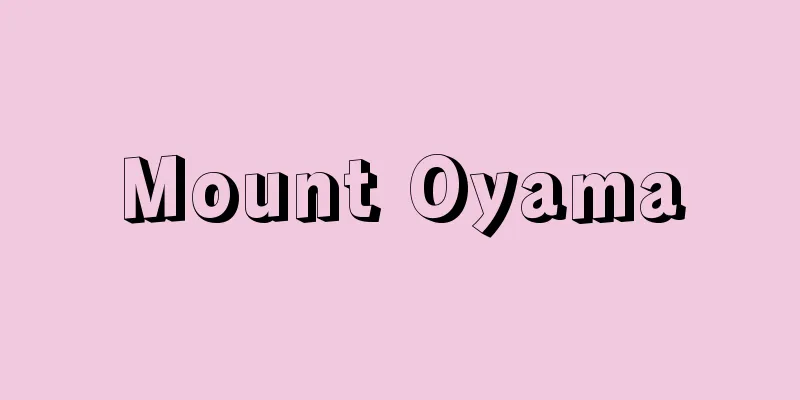Mount Oyama

This is the former town area in the northwest of Tsuruoka City, in the west of Yamagata Prefecture. It is located at the eastern foot of the Kamo Plateau (→ Kamo). It was established as a town in 1890. It was merged with Saigo Village in 1955. It was incorporated into Tsuruoka City in 1963. It was once a castle town with a sturdy mountain castle called Oura Castle (Oyama Castle) on Mt. Taihei at the eastern foot of Mt. Takadate. During the Tensho era, it was the residence of the Muto clan, but later the lord of Tsuruoka Castle, Sakai Bitchu-no-kami, was given the territory, and it then became the territory of the Edo Shogunate and a magistrate's office was established there. With good quality water, rice from the Shonai Plain, and cedar barrels from Mise, sake brewing began in the Genroku era, and the first product was sent to Edo in 1798. During the Meiji era, 10,000 to 30,000 koku of sake was produced. It is still known as a producer of fine sake. The castle site is now Oyama Park, a famous cherry blossom viewing spot. The Dog Festival (June 5th) at Sugio Shrine in Umamachi is famous.Mount OyamaMount OyamaMt. OyamaMount OyamaSource: Encyclopaedia Britannica Concise Encyclopedia About Encyclopaedia Britannica Concise Encyclopedia Information |
山形県西部,鶴岡市北西部の旧町域。加茂台地 (→加茂 ) の東麓にある。 1890年町制施行。 1955年西郷村と合体。 1963年鶴岡市に編入。かつて高館山東麓の太平山に尾浦城 (大山城) と呼ばれる堅固な山城があった城下町で,天正年間は武藤氏が居城したが,のち鶴岡城主酒井備中守が分知され,次いで江戸幕府領となり代官所が置かれた。良質な水と庄内平野の米,三瀬の杉樽により元禄の頃より酒の醸造が始まり,寛政 10 (1798) 年に初めて製品が江戸に送られた。明治期には1万~3万石の酒が生産された。現在も銘酒の産地として知られる。城址は大山公園となり,サクラの名所。馬町にある椙尾神社 (すぎのおじんじゃ) の犬まつり (6月5日) は有名。
大山
|
Recommend
Concave polygon - Concave polygon
A polygon that contains at least one interior angl...
Operations Research
Also known as OR (short for operations research). ...
Auspicious star - Igaboshi
〘Noun〙 (also called "ikaboshi") One of t...
Money Lending Business Act
This law amended the Money Lending Business Regula...
Lira (English spelling)
The Italian currency. One lira (abbreviated as L) ...
Coreopsis drummondii (English spelling)
… [Eiichi Asayama]. … *Some of the terms that men...
Assisi (English spelling)
A city in the province of Perugia in Umbria, centr...
Carson City
The capital of Nevada, located in the western end ...
Heim, G. (English spelling) HeimG
...On the other hand, the Liberals, whose main ba...
Cheek muscles - Kyokin
Muscles in the cheek area. Source: About Shogakuka...
British Institution of Civil Engineers
...Thus, civil engineering developed as part of m...
Citric Acid Cycle
Also known as the TCA cycle, Krebs cycle, tricarbo...
Integrating sphere - SEKIBUNKYU
A hollow sphere for measuring the luminous flux of...
Lycaeides argyrognomon (English spelling) Lycaeidesargyrognomon
…[Mayumi Takahashi]. . . *Some of the terminology...
Takeshi [Village] - Takeshi
A village in Chiisagata County, central Nagano Pre...



![Omachi [town] - Omachi](/upload/images/67cb183420ed0.webp)





